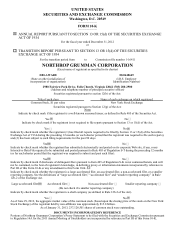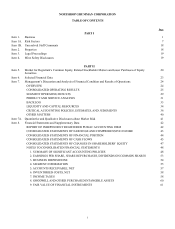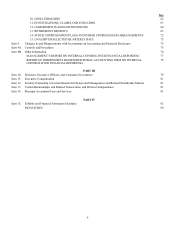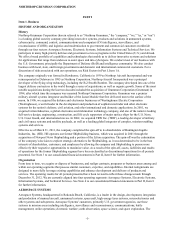Northrop Grumman 2012 Annual Report Download - page 17
Download and view the complete annual report
Please find page 17 of the 2012 Northrop Grumman annual report below. You can navigate through the pages in the report by either clicking on the pages listed below, or by using the keyword search tool below to find specific information within the annual report.
NORTHROP GRUMMAN CORPORATION
-7-
AVAILABLE INFORMATION
Our principal executive offices are located at 2980 Fairview Park Drive, Falls Church, Virginia 22042. Our
telephone number is (703) 280-2900 and our home page on the Internet is www.northropgrumman.com.
Our annual reports on Form 10-K, quarterly reports on Form 10-Q, current reports on Form 8-K, and proxy
statement for the annual shareholders’ meeting, as well as any amendments to those reports, are available free of
charge through our Web site as soon as reasonably practicable after we file them with the Securities and Exchange
Commission (SEC). You can learn more about us by reviewing our SEC filings on the investor relations page of our
Web site.
The SEC also maintains a Web site at www.sec.gov that contains reports, proxy statements and other information
about SEC registrants, including Northrop Grumman Corporation. You may also obtain these materials at the SEC’s
Public Reference Room at 100 F Street, N.E., Washington, D.C. 20549. You can obtain information on the operation
of the Public Reference Room by calling the SEC at 1-800-SEC-0330.
References to our Web site and the SEC’s Web site in this report are provided as a convenience and do not
constitute, and should not be viewed as, incorporation by reference of the information contained on, or available
through, such Web sites. Such information should not be considered a part of this report, unless otherwise expressly
incorporated by reference in this report.
Item 1A. Risk Factors
Our consolidated financial position, results of operations and cash flows are subject to various risks, many of which
are not exclusively within our control, that may cause actual performance to differ materially from historical or
projected future performance. We urge you to carefully consider the risk factors described below in evaluating the
information contained in this report.
We depend heavily on a single customer, the U.S. Government, for a substantial portion of our business. Changes
in this customer’s priorities and spending could have a material adverse effect on our financial position, results
of operations, or cash flows.
Our primary customer is the U.S. Government, from which we derived more than 90 percent of our total revenues
during each of the past several years. The U.S. Government is implementing significant reductions in government
spending and other significant program changes. We cannot predict the impact on existing, follow-on, replacement
or future programs from potential changes in priorities due to changes in defense spending levels, military strategy
and planning, and/or changes in social-political priorities. A shift in government priorities to programs in which we
do not participate and/or reductions in funding for or the termination of programs in which we do participate, unless
offset by other programs and opportunities, could have a material adverse effect on our financial position, results of
operations and cash flows.
The U.S. Government generally has the ability to terminate contracts, in whole or in part, without prior notice, for its
convenience or for default based on performance. In the event of termination for the U.S. Government’s
convenience, contractors are generally protected by provisions covering reimbursement for costs incurred on the
contracts and profit on those costs but not the anticipated profit that would have been earned had the contract been
completed. In some circumstances, however, a U.S. government contract does not have such termination protection.
In those cases, we attempt to mitigate the termination risk through other means. To the extent such means are
unavailable or do not fully address the costs incurred or profit on those costs, we could face significant losses from
the termination for convenience of a contract that lacks termination protection. Termination by the U.S. Government
of a contract for convenience also could result in the cancellation of future work on that program. Termination by the
U.S. Government of a contract due to our default could require us to pay for re-procurement costs in excess of the
original contract price, net of the value of work accepted from the original contract, as well as other damages.
Termination of a contract due to our default may expose us to material liability and could have a material adverse
effect on our ability to compete for other contracts.
The U.S. Government also has the ability to stop work under a contract for a limited period of time for its
convenience. It is possible that the U.S. Government could invoke this ability across a limited or broad number of
contracts in this challenging fiscal environment. In the event of a stop work order, contractors are generally
protected by provisions covering reimbursement for costs incurred on the contract to date and for costs associated
with the temporary stoppage of work on the contract. However, such temporary stoppages and delays could
introduce inefficiencies for which we may not be able to negotiate full recovery from the U.S. Government, and
could ultimately result in termination for convenience or reduced future orders on certain contracts. In this
























